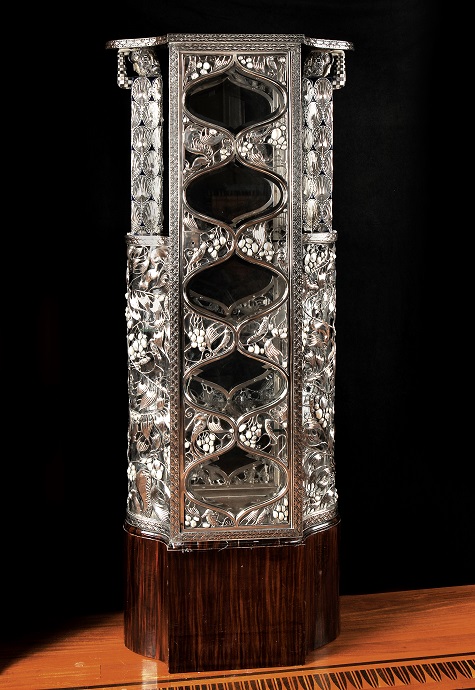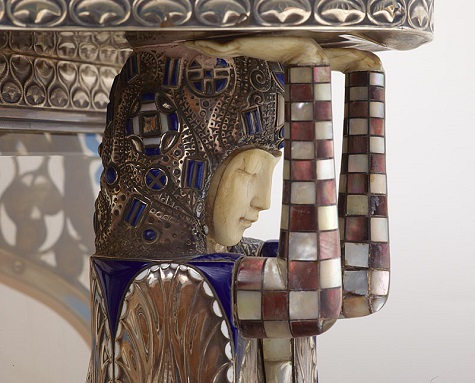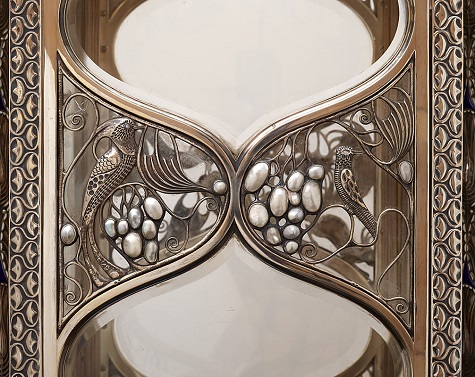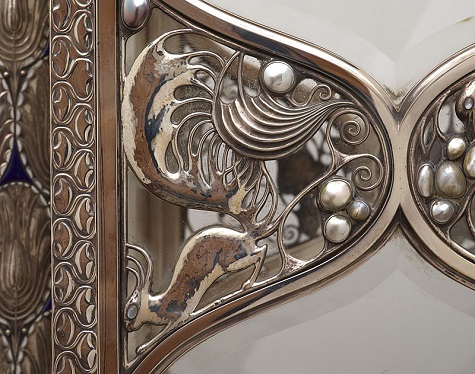The Dallas Museum of Art recently acquired the Wittgenstein silver cabinet, a stunning example of early 20th-century design from the Wiener Werkstätte (Vienna Workshops, founded 1903), which was a major producer of lavishly designed silverwork. Intended to be a work of art as much as the objects housed within it, the cabinet (also called a “vitrine”) demonstrates a shift in design toward an elaborate ornamental aesthetic.

Silver vitrine (for the 1908 Kunstschau), 1908, Wiener Werkstätte (Vienna Workshops), Vienna, Austria, 1903-32, maker; Carl Otto Czeschka, Austrian, 1878-1960, designer; Josef Berger, Austrian, 1874/75-?, goldsmith; Josef Hoszfeld, Austrian, 1869-1918, Adolf Erbrich, Austrian, 1874-?, Alfred Mayer, Austrian, 1873-?, silversmiths; Josef Weber, dates unknown, cabinetmaker; Wabak, Albrech, Plasinsky, Cerhan (unidentified craftsmen), silver, moonstone, opal, lapis lazuli, mother-of-pearl, baroque pearls, onyx, marble, ivory, enamel, glass, and Macassar ebony veneers (replaced), image courtesy of Richard Nagy Ltd, London, Dallas Museum of Art, The Eugene and Margaret McDermott Art Fund, Inc.
Currently on view in its own niche gallery on Level 2, and included in free general admission, the cabinet initially stuns visitors with its brilliant polished finish and begs for closer inspection, enticing viewers with brightly colored enamel, pearls, opals and other gemstones.

Two female figures, called “caryatids,” support the cabinet’s onyx top while emphasizing the verticality of the object and giving the flowing organic design an added sense of regal structure. Bright blue enamel and bold patterns draw the eye to these elegant figures.

If you look closely, you will see a wide variety of birds, some with elaborate plumage and others so small they seem to disappear among the leaves and pearls. Gemstones dot the eyes of the birds, giving them a spark of life despite their metallic forms.

Squirrels frolic around the cabinet, hiding among the leaves and gathering pearls like acorns. Like the birds, their gemstone eyes enliven them and their differing poses suggest their distinct personalities. Further, the animals represent multiple breeds, including the red squirrel with tufted ears and the grey squirrel with rounded ears.
The cabinet by the numbers:
2 – caryatids
3 – cubic feet of wood
4 – interior glass shelves
5 – feet tall
10 – types of birds
14 – squirrels
If you look really closely, you will find other animals like lizards and mice!
Alexa Hayes is the McDermott Graduate Curatorial Intern for American and Decorative Art at the DMA.
great info